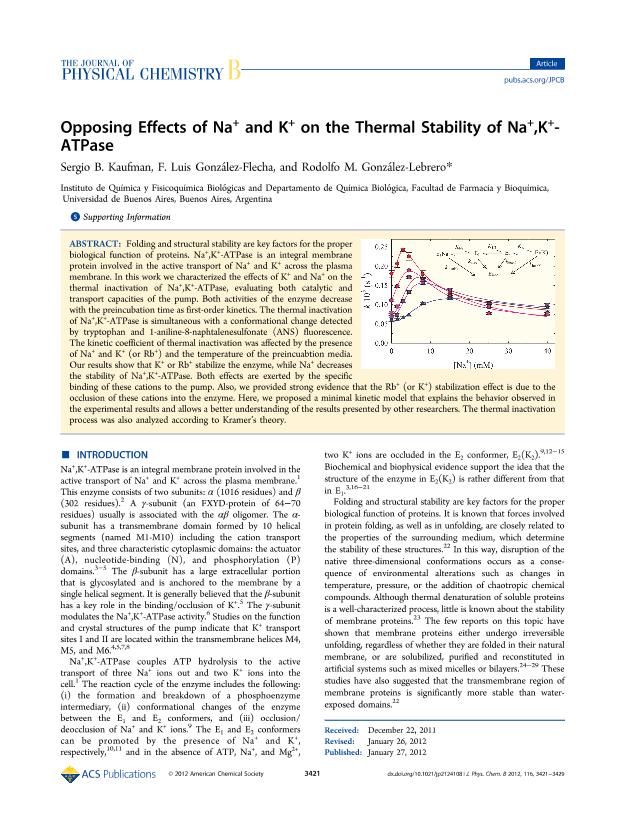Artículo
Opposing effects of Na+ and K+ on the thermal stability of Na+,K+-ATPase
Fecha de publicación:
03/2012
Editorial:
American Chemical Society
Revista:
Journal of Physical Chemistry B
ISSN:
1520-6106
Idioma:
Inglés
Tipo de recurso:
Artículo publicado
Clasificación temática:
Resumen
Folding and structural stability are key factors for the proper biological function of proteins. Na+,K+-ATPase is an integral membrane protein involved in the active transport of Na+ and K+ across the plasma membrane. In this work we characterized the effects of K+ and Na+ on the thermal inactivation of Na+,K+-ATPase, evaluating both catalytic and transport capacities of the pump. Both activities of the enzyme decrease with the preincubation time as first-order kinetics. The thermal inactivation of Na+,K+-ATPase is simultaneous with a conformational change detected by tryptophan and 1-aniline-8-naphtalenesulfonate (ANS) fluorescence. The kinetic coefficient of thermal inactivation was affected by the presence of Na+ and K+ (or Rb+) and the temperature of the preincuabtion media. Our results show that K+ or Rb+ stabilize the enzyme, while Na+ decreases the stability of Na+,K+-ATPase. Both effects are exerted by the specific binding of these cations to the pump. Also, we provided strong evidence that the Rb+ (or K+) stabilization effect is due to the occlusion of these cations into the enzyme. Here, we proposed a minimal kinetic model that explains the behavior observed in the experimental results and allows a better understanding of the results presented by other researchers. The thermal inactivation process was also analyzed according to Kramer’s theory.
Palabras clave:
Thermal Inactivation
,
Na+,K+-Atpase
,
Conformational Change
Archivos asociados
Licencia
Identificadores
Colecciones
Articulos(IQUIFIB)
Articulos de INST.DE QUIMICA Y FISICO-QUIMICA BIOLOGICAS "PROF. ALEJANDRO C. PALADINI"
Articulos de INST.DE QUIMICA Y FISICO-QUIMICA BIOLOGICAS "PROF. ALEJANDRO C. PALADINI"
Citación
Kaufman, Sergio Benjamín; Gonzalez Flecha, Francisco Luis; Gonzalez-Lebrero, Rodolfo Martin; Opposing effects of Na+ and K+ on the thermal stability of Na+,K+-ATPase; American Chemical Society; Journal of Physical Chemistry B; 116; 10; 3-2012; 3421-3429
Compartir
Altmétricas




